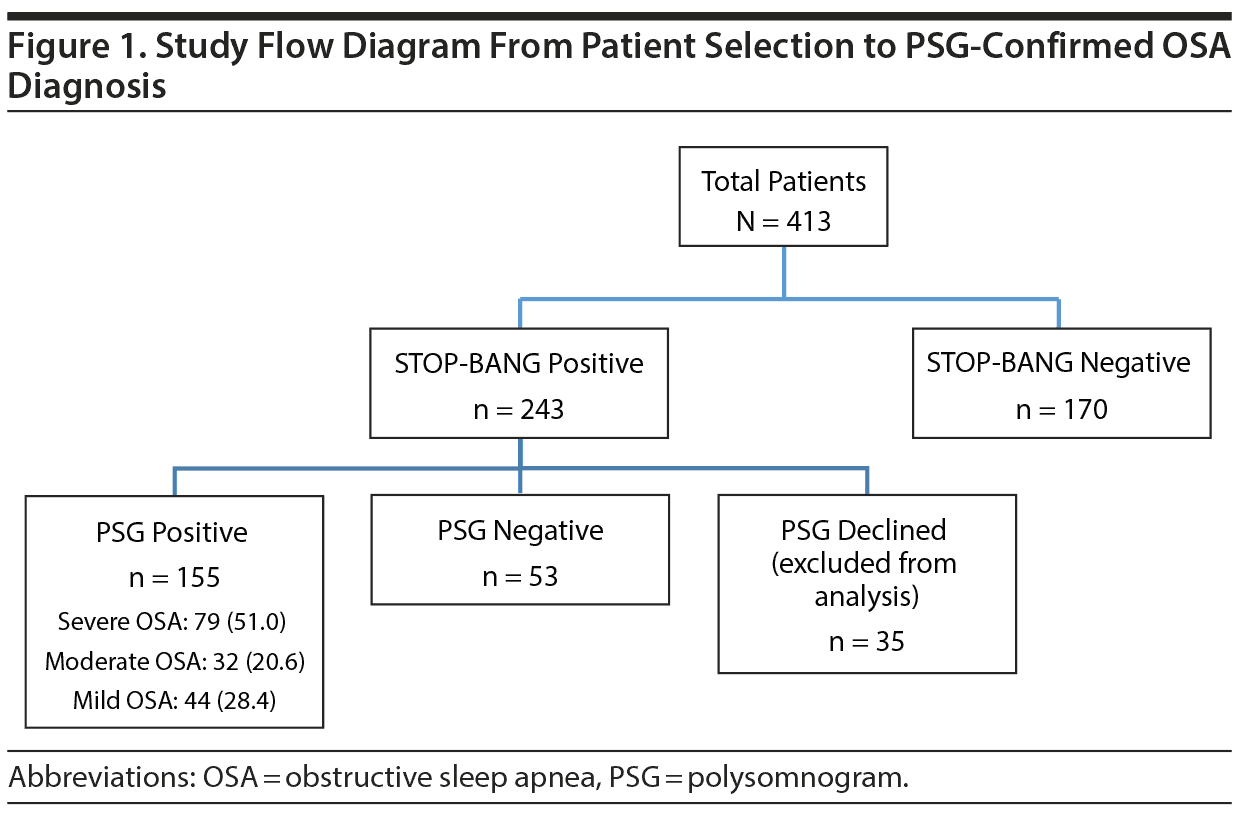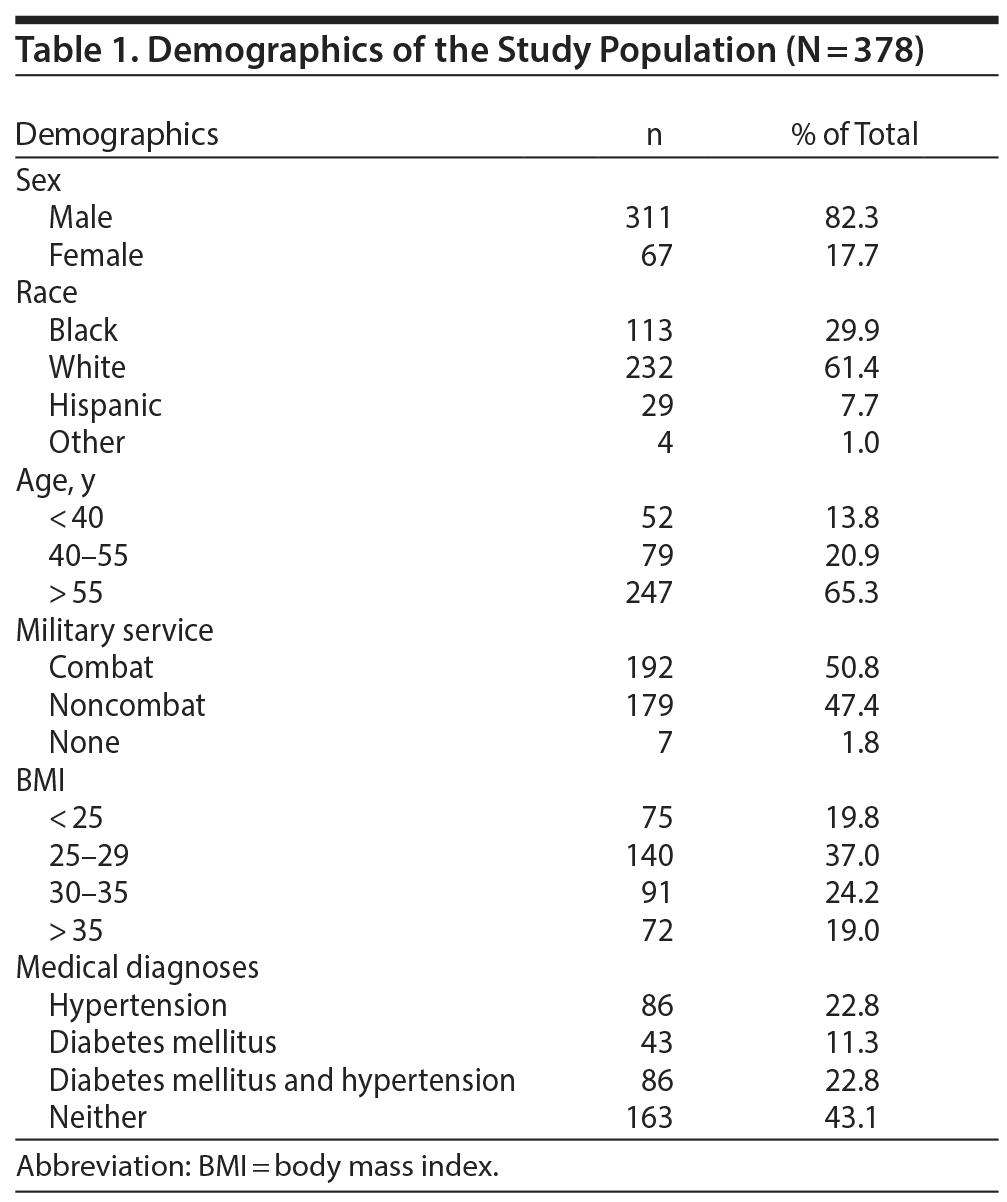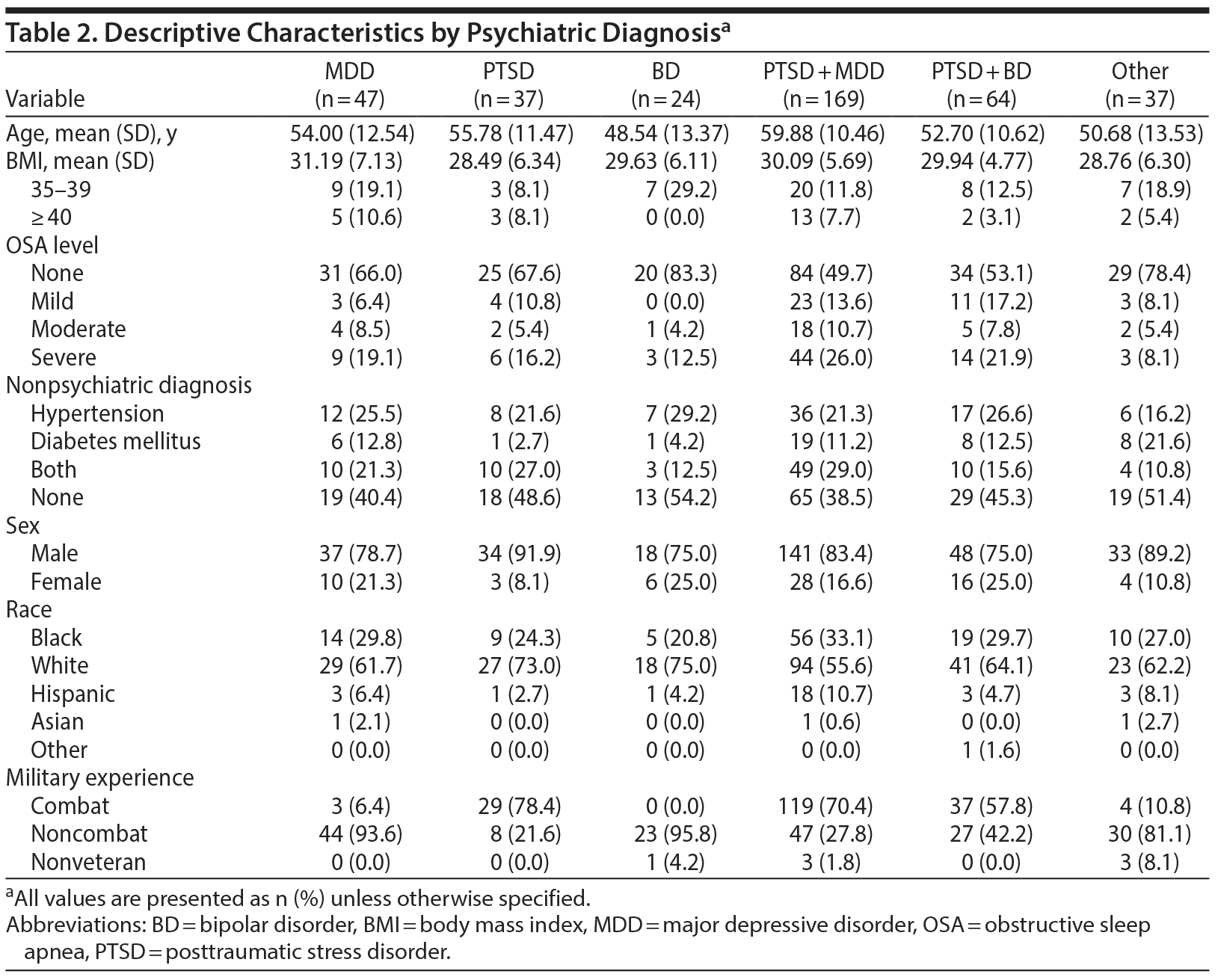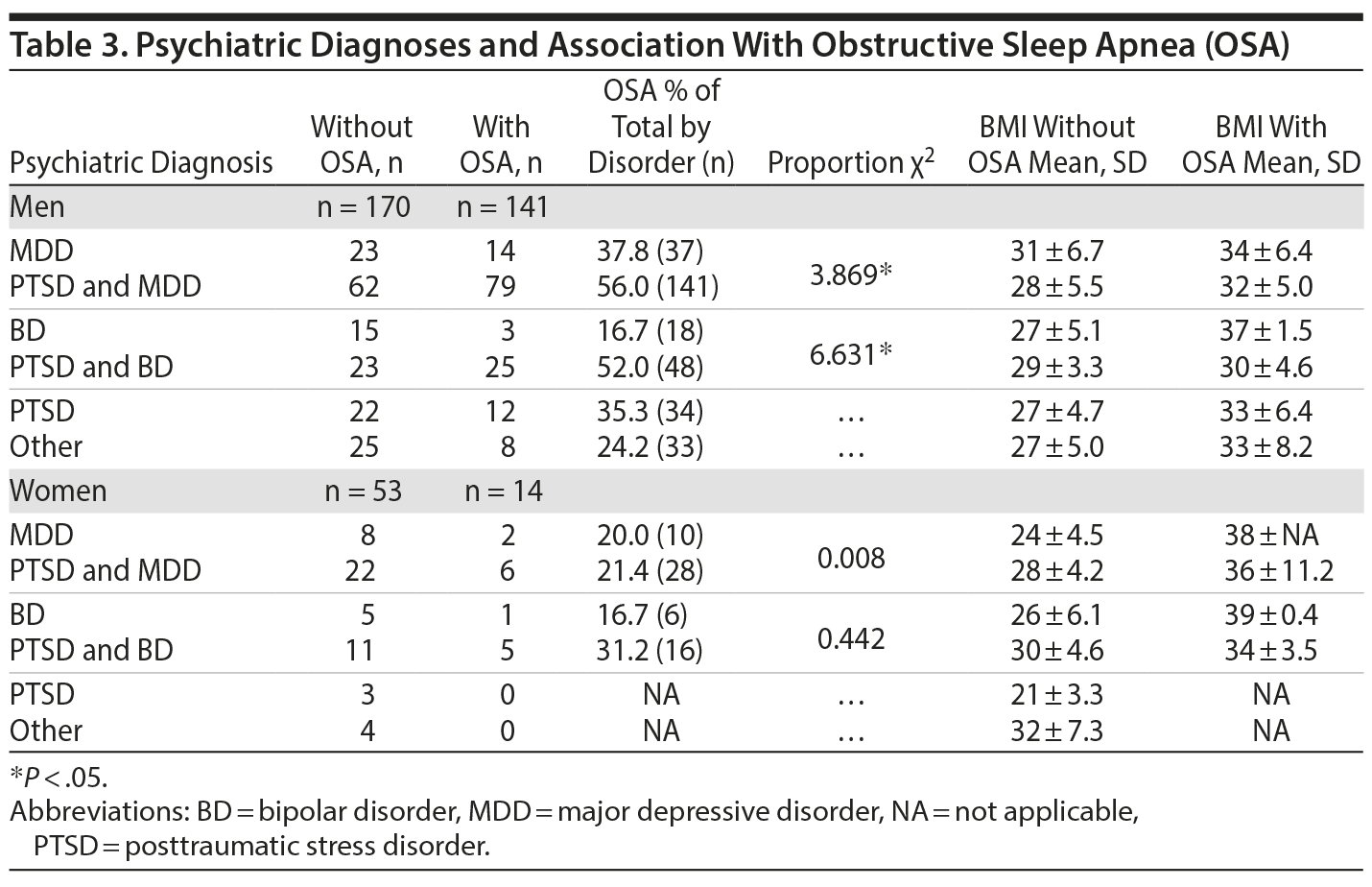Objective: To examine the correlations between obstructive sleep apnea (OSA) and psychiatric disorders such as major depressive disorder (MDD), posttraumatic stress disorder (PTSD), or bipolar disorder (BD) and whether comorbid psychiatric diagnosis increases the risk of OSA.
Methods: This retrospective chart review study included all patients (N = 413) seen within a randomly selected 4-month period (August 2014 to November 2014) in a Veterans Administration outpatient psychiatry clinic. Patients were screened for symptoms of OSA with the STOP-BANG Questionnaire. Those with a positive screen were referred to the sleep clinic for confirmation of the diagnosis by polysomnogram (PSG). Frequency of PSG-confirmed OSA was correlated with different psychiatric disorders and comorbid psychiatric diagnoses.
Results: The study showed a high prevalence of OSA in psychiatric patients, particularly with MDD (37.8%) and PTSD (35.5%) and less so with BD (16.7%). Among all patients with OSA (n = 155), those with comorbid BD and PTSD had a significantly higher rate of OSA than those with BD alone (χ2 = 7.28, P < .05) but not with PTSD alone. We also found a statistically significant higher incidence of OSA in male veterans with either MDD comorbid with PTSD (χ2 = 3.869, P < .05) or BD comorbid with PTSD (χ2 = 6.631, P < .05) compared with either mood disorder or PTSD alone.
Conclusions: The study showed a high prevalence of OSA in psychiatric patients, particularly in those with PTSD and MDD and less so with BD. There was a statistically significant increase in the incidence of OSA in male veterans with either BD with comorbid PTSD or MDD with comorbid PTSD.’ ‹’ ‹

Obstructive Sleep Apnea in Posttraumatic Stress Disorder Comorbid With Mood Disorder:
Significantly Higher Incidence Than in Either Diagnosis Alone
ABSTRACT
Objective: To examine the correlations between obstructive sleep apnea (OSA) and psychiatric disorders such as major depressive disorder (MDD), posttraumatic stress disorder (PTSD), or bipolar disorder (BD) and whether comorbid psychiatric diagnosis increases the risk of OSA.
Methods: This retrospective chart review study included all patients (N = 413) seen within a randomly selected 4-month period (August 2014 to November 2014) in a Veterans Administration outpatient psychiatry clinic. Patients were screened for symptoms of OSA with the STOP-BANG Questionnaire. Those with a positive screen were referred to the sleep clinic for confirmation of the diagnosis by polysomnogram (PSG). Frequency of PSG-confirmed OSA was correlated with different psychiatric disorders and comorbid psychiatric diagnoses.
Results: The study showed a high prevalence of OSA in psychiatric patients, particularly with MDD (37.8%) and PTSD (35.5%) and less so with BD (16.7%). Among all patients with OSA (n = 155), those with comorbid BD and PTSD had a significantly higher rate of OSA than those with BD alone (χ2 = 7.28, P < .05) but not with PTSD alone. We also found a statistically significant higher incidence of OSA in male veterans with either MDD comorbid with PTSD (χ2 = 3.869, P < .05) or BD comorbid with PTSD (χ2 = 6.631, P < .05) compared with either mood disorder or PTSD alone.
Conclusions: The study showed a high prevalence of OSA in psychiatric patients, particularly in those with PTSD and MDD and less so with BD. There was a statistically significant increase in the incidence of OSA in male veterans with either BD with comorbid PTSD or MDD with comorbid PTSD.
Prim Care Companion CNS Disord 2018;20(4):18m02281
To cite: Fehr BS, Katz WF, Van Enkevort EA, et al. Obstructive sleep apnea in posttraumatic stress disorder comorbid with mood disorder: significantly higher incidence than with either diagnosis alone. Prim Care Companion CNS Disord. 2018;20(4):18m02281.
To share: https://doi.org/10.4088/PCC.18m02281
© Copyright 2018 Physicians Postgraduate Press, Inc.
aDepartment of Psychiatry, Veterans Affairs North Texas Health Care System, Dallas, Texas
bDepartment of Psychiatry, UT Southwestern Medical School, Dallas, Texas
cSchool of Behavioral and Brain Sciences, University of Texas at Dallas, Dallas, Texas
dCenter for Sleep Medicine, Department of Neurology, Veterans Affairs North Texas Health Care System, Dallas, Texas
eDepartment of Neurology and Neurotherapeutics, UT Southwestern Medical School, Dallas, Texas
*Corresponding author: Bettina S. Fehr, MD, Veterans Affairs North Texas Health Care System, Mental Health Service 116A, 4500 S. Lancaster Rd, Dallas, Texas 75216 ([email protected]).
Major depressive disorder (MDD) and posttraumatic stress disorder (PTSD) are associated with increased prevalence of obstructive sleep apnea (OSA).1-4 Some studies5,6 suggest that treating OSA improves symptoms of PTSD and MDD. Treatment of OSA is complicated in patients with MDD and PTSD, as there are lower adherence rates of continuous positive airway pressure (CPAP) use in this patient population.6,7 Little work has been done to evaluate the incidence of OSA in patients with both depression and PTSD. The purpose of this retrospective chart review study is to examine if additional psychiatric diagnosis increases the risk of OSA in patients seen in a Veterans Administration (VA) general psychiatry outpatient clinic. In addition, this study evaluates the incidence of OSA in bipolar disorder (BD) in these patients.

- Clinicians should routinely screen for obstructive sleep apnea (OSA) in psychiatric patients.
- In men with comorbid mood disorder and posttraumatic stress disorder, the incidence of OSA is higher than in men with a single diagnosis.
- Clinicians might consider using a tool to help screen for OSA, such as the STOP-BANG Questionnaire.
METHODS
The frequency of OSA in patients followed in a general VA outpatient psychiatry clinic and its association with psychiatric disorders was analyzed via retrospective chart review. Subjects included 413 patients (none excluded) seen within a randomly selected 4-month period (August 2014 to November 2014). Four months is the time frame corresponding to the usual interval for the follow-up visits of most patients and represents approximately the number of unique patients in active treatment followed by 1 psychiatrist. The 413 patients were screened for symptoms of OSA with the STOP-BANG Questionnaire8 in the context of routine clinical care by the psychiatrist. The STOP-BANG Questionnaire is the clinical screening tool for OSA used at the VA North Texas Health Care System. Patients with a score ≥ 5 (of a total of 8 points), which is considered positive and corresponds to a high likelihood for OSA, are referred for polysomnogram (PSG). All patients who tested positive on the STOP-BANG Questionnaire were offered PSG testing for OSA. Of the 243 positive patients, 208 accepted referral to the sleep clinic, while 35 declined and were excluded from further analysis. A study flow diagram is provided in Figure 1.
Demographics of the population included in the analysis (N = 378; 311 men and 67 women) as well as medical comorbidities (hypertension or diabetes mellitus) are summarized in Table 1. None of the patients had active substance use disorders, as those patients are followed in a specialized clinic for substance use disorders in this institution. Psychiatric diagnoses were determined according to DSM-5 criteria by the psychiatrist. The majority had a mood disorder and PTSD (Tables 2 and 3). Descriptive characteristics among psychiatric diagnoses are presented in Table 2. Medical diagnoses, including hypertension and diabetes mellitus, were determined by VA primary care providers and were documented in the charts (Tables 1 and 2).
Patients who agreed to PSG testing were diagnosed with OSA if their apnea-hypopnea index (AHI) was ≥ 5 on the polysomnogram. Sleep apnea levels are defined as mild (AHI of 5-14), moderate (AHI of 15-29), and severe (AHI of ≥ 30).
RESULTS
The PSG results of 141 men (45% of men) and 14 women (21% of women) were positive for OSA. Patients with OSA ranged from 27 to 70 years old (mean age = 59, SD = 10.15). Incidence of OSA increased with age (≥ 55 years, 47.2%; 40-54 years, 36.3%; and < 40 years, 19.2%) and was significantly higher in men than in women (χ2 = 13.2, P < .01), corresponding with previous findings.1,3
We analyzed psychiatric diagnoses for comorbidity with OSA (Table 3). Six diagnosis groups were defined: MDD, BD, PTSD, comorbid MDD with PTSD, comorbid BD with PTSD, and other (including schizophrenia, attention-deficit disorder, and anxiety disorders). Patients in the “other” group were excluded from statistical analyses due to their diagnostic heterogeneity and low numbers. A χ2 test of proportion of all patients with OSA (n = 155) indicated that patients with comorbid BD and PTSD had a significantly higher rate of OSA than patients with BD alone (χ2 = 7.28, P < .05) but not with PTSD alone (χ2 = 2.009, P = .156, not significant). Since men show overall higher OSA incidence than women, these differences were further analyzed by sex (Table 3). Results indicate significant differences for men, but not for women, in the comorbid BD-PTSD versus BD alone comparison (χ2 = 6.631, P < .05). However, the comorbid BD with PTSD versus PTSD alone comparison was not significant (χ2 = 1.245, P = .264). In addition, men with OSA showed a significant difference in incidence of OSA between the comorbid MDD with PTSD group compared to individuals with MDD alone (χ2 = 3.869, P < .05) and compared to individuals with PTSD alone (χ2 = 4.676, P < .05).
Only 14 women tested positive for OSA. All women who presented with OSA had a mood disorder or comorbidity of a mood disorder with PTSD. There were no statistical differences between any of the diagnosis groups analyzed, most likely resulting from low statistical power.
Body mass index data (last 2 columns of Table 3) reveal that for all diagnoses, BMI is higher for patients with OSA as anticipated.6,7 However, due to significant variability, this difference was only significant for men with BD (t31 = −3.344, P = .002).
DISCUSSION
This study shows a high association of OSA with psychiatric diagnoses, particularly with MDD (37.8%) and PTSD (35.3%) and less so with BD (16.7%), which is similar to findings of previous studies.1-3 Most importantly, the current study provides, to our knowledge, the first evidence of a statistically significant increased incidence of OSA in male veterans with either BD with comorbid PTSD or MDD with comorbid PTSD. The small number of women with OSA resulted in low power to detect meaningful differences between diagnostic groups. These correlations should be addressed in future studies using larger numbers of women with OSA. The combination of a mood disorder with PTSD may pose an additional risk factor for OSA, possibly related to additional disruptive effects on sleep continuity by PTSD as noted in previous studies.1-4 Sleep fragmentation in PTSD might be one of the factors that increases the risk of OSA, as going back and forth between sleep and wakefulness destabilizes the upper airway and increases upper airway collapsibility.9 Also, treating OSA in patients with PTSD has been shown in several studies9-12 to decrease nightmares and improve PTSD symptoms. A recent prospective cohort study5 reported improvement of PTSD symptoms in veterans with OSA was more marked with prolonged use of CPAP. Compliance to treatment was related to improvement in nightmare distress and frequency.
In the present study, all patients were treated with more than 1 psychotropic medication and several medications for medical conditions. Therefore, it is possible that many of these patients had effects of individual medications on their incidence or severity level of OSA. For instance, medication such as second-generation antipsychotics or mood stabilizers could contribute to weight gain, which, in turn, increases incidence of OSA. However, in the present data, BMI appeared to play no role in the incidence of OSA among the 6 psychiatric diagnoses groups.
There are several limitations to our study as it used a retrospective chart review design. The population was veterans from an outpatient clinic, which usually caters to patients with severe and complicated psychiatric disease, and the results are thus not likely generalizable to other psychiatric clinic populations. However, the strengths include PSG use to diagnose OSA, which is the gold standard for diagnosing OSA, and clinical diagnosis of psychiatric condition instead of self-administered questionnaires used in other studies. Despite the limitations, this study is one of the first to evaluate the increased incidence of OSA in patients with 2 comorbid psychiatric conditions, namely MDD with PTSD and BD with PTSD. This study highlights the importance of screening patients with severe psychiatric disorders for sleep apnea, particularly those with dual diagnoses of mood disorders and PTSD.
Submitted: January 31, 2018; accepted April 11, 2018.
Published online: August 9, 2018.
Disclosure of off-label usage: The authors have determined that, to the best of their knowledge, no investigational information about pharmaceutical agents that is outside US Food and Drug Administration-approved labeling has been presented in this article.
Financial disclosure: Drs Fehr, Katz, Van Enkevort, and Khawaja have no personal affiliations or financial relationships with any commercial interest to disclose relative to the article.
Funding/support: None.
Find more articles on this and other psychiatry and CNS topics:
The Journal of Clinical Psychiatry
The Primary Care Companion for CNS Disorders
REFERENCES
1. Sharafkhaneh A, Giray N, Richardson P, et al. Association of psychiatric disorders and sleep apnea in a large cohort. Sleep. 2005;28(11):1405-1411. PubMed CrossRef
2. Stubbs B, Vancampfort D, Veronese N, et al. The prevalence and predictors of obstructive sleep apnea in major depressive disorder, bipolar disorder and schizophrenia: a systematic review and meta-analysis. J Affect Disord. 2016;197:259-267. PubMed CrossRef
3. Babson KA, Del Re AC, Bonn-Miller MO, et al. The comorbidity of sleep apnea and mood, anxiety, and substance use disorders among obese military veterans within the Veterans Health Administration. J Clin Sleep Med. 2013;9(12):1253-1258. PubMed
4. Yesavage JA, Kinoshita LM, Kimball T, et al. Sleep-disordered breathing in Vietnam veterans with posttraumatic stress disorder. Am J Geriatr Psychiatry. 2012;20(3):199-204. PubMed CrossRef
5. El-Solh AA, Vermont L, Homish GG, et al. The effect of continuous positive airway pressure on posttraumatic stress disorder symptoms in veterans with posttraumatic stress disorder and obstructive sleep apnea: a prospective study. Sleep Med. 2017;33:145-150. PubMed CrossRef
6. Ejaz SM, Khawaja IS, Bhatia S, et al. Obstructive sleep apnea and depression: a review. Innov Clin Neurosci. 2011;8(8):17-25. PubMed
7. Collen JF, Lettieri CJ, Hoffman M. The impact of posttraumatic stress disorder on CPAP adherence in patients with obstructive sleep apnea. J Clin Sleep Med. 2012;8(6):667-672. PubMed
8. Chung F, Abdullah HR, Liao P. STOP-BANG Questionnaire: a practical approach to screen for obstructive sleep apnea. Chest. 2016;149(3):631-638. PubMed CrossRef
9. Krakow B, Lowry C, Germain A, et al. A retrospective study on improvements in nightmares and post-traumatic stress disorder following treatment for co-morbid sleep-disordered breathing. J Psychosom Res. 2000;49(5):291-298. PubMed CrossRef
10. Ullah MI, Campbell DG, Bhagat R, et al. Improving PTSD symptoms and preventing progression of subclinical PTSD to an overt disorder by treating comorbid OSA with CPAP. J Clin Sleep Med. 2017;13(10):1191-1198. PubMed CrossRef
11. Hurwitz TD, Khawaja I. Treatment of obstructive sleep apnea may be an important adjunct to therapy of posttraumatic stress disorder not to be overlooked. Sleep. 2010;33(11):1435-1436. PubMed CrossRef
12. Krakow BJ, Obando JJ, Ulibarri VA, et al. Positive airway pressure adherence and subthreshold adherence in posttraumatic stress disorder patients with comorbid sleep apnea. Patient Prefer Adherence. 2017;11:1923-1932. PubMed CrossRef
Please sign in or purchase this PDF for $40.00.
Save
Cite






